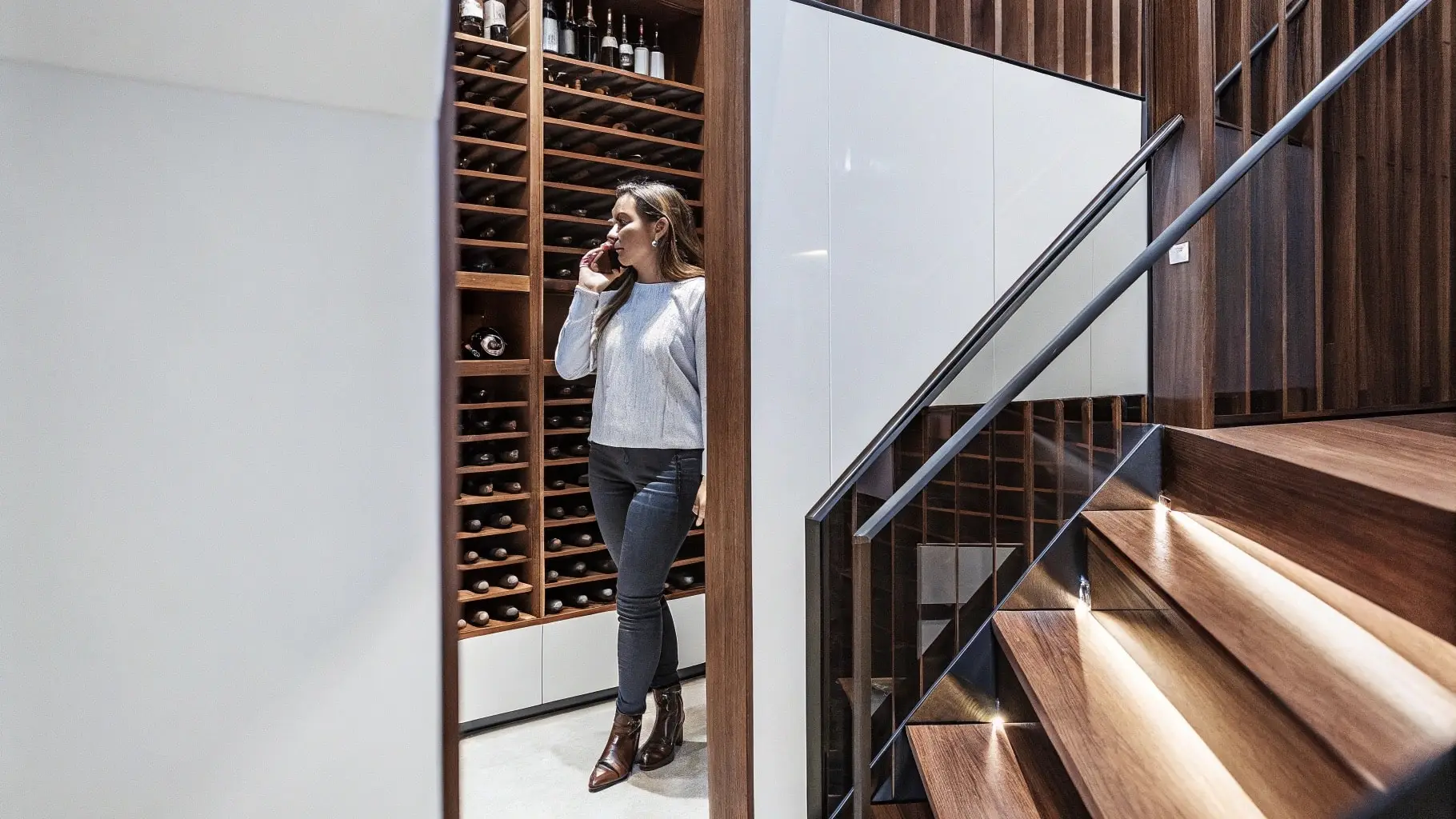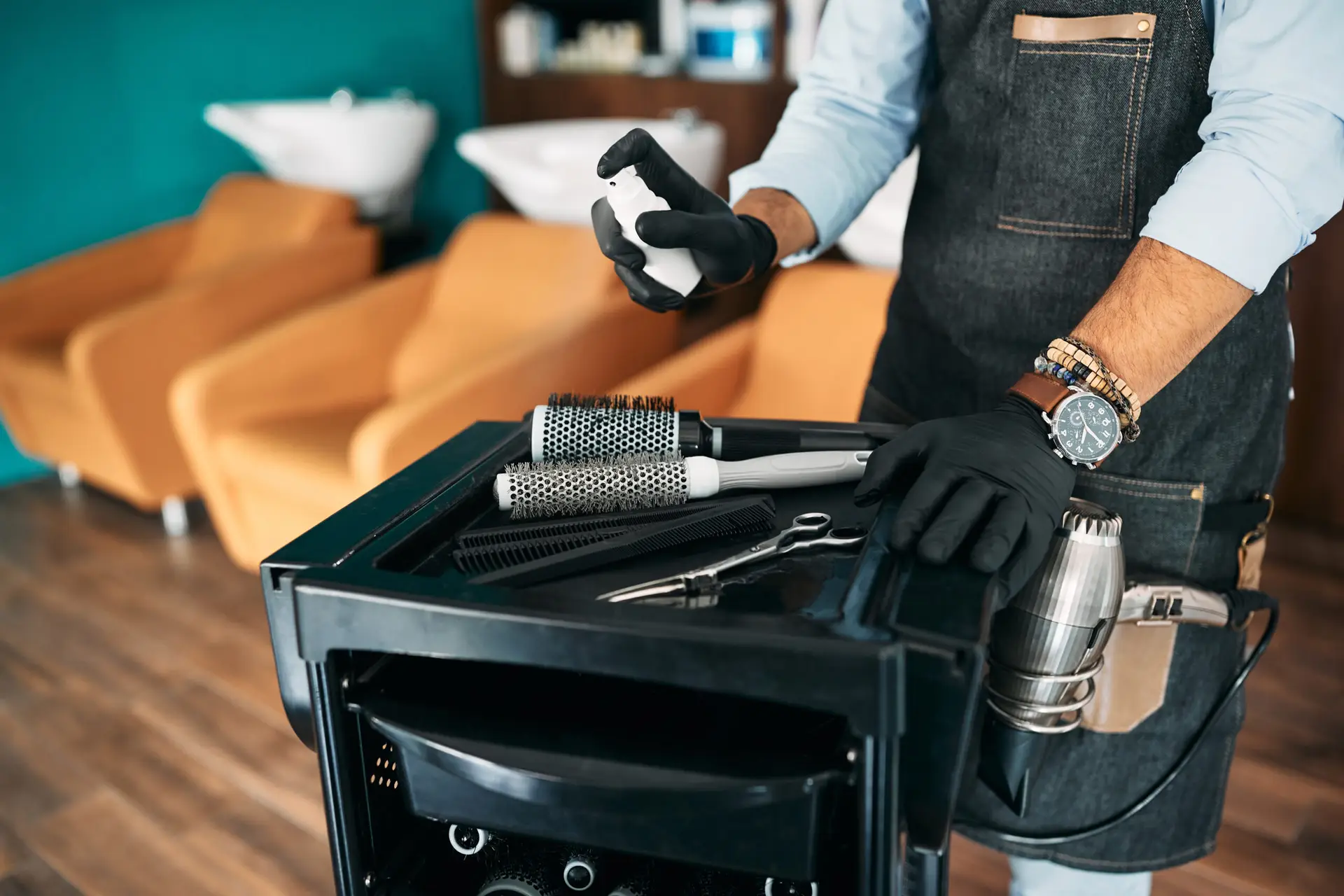In the challenging climate of Houston and Dallas, maintaining the perfect environment for your wine collection requires a properly functioning refrigeration system. When refrigerant leaks develop in high-end wine cellar cooling units, they not only compromise the ideal storage conditions but can also lead to expensive repairs or, worse, damage to your valuable wine collection.
At Uptown Appliance Repair, we understand the critical nature of wine cellar refrigeration, especially in premium systems from manufacturers like Sub-Zero, Viking, and Thermador.
This comprehensive guide will help you understand how to detect refrigerant leaks early, what steps to take when they occur, and how to prevent future problems in your wine cellar refrigeration system.
Understanding Refrigerant in Wine Cellar Cooling Systems
The Role of Refrigerant
Refrigerant is the lifeblood of your wine cellar cooling system. These specialized chemical compounds (commonly known by brand names like Freon) are designed to absorb heat from inside your wine cellar and release it outside, maintaining the precise temperature required for proper wine storage.
Unlike standard home refrigerators, wine cellar refrigeration systems are engineered to maintain an extremely narrow temperature range (typically 55-58°F) with minimal fluctuations, while also managing humidity levels between 60-70%. This delicate balance requires a perfectly functioning refrigerant system.
Why Refrigerant Leaks Occur in Texas Wine Cellars
Wine cellar refrigeration systems in Houston and Dallas face unique challenges that can increase the likelihood of refrigerant leaks:
- Extreme Temperature Fluctuations
The dramatic seasonal temperature shifts in Texas put exceptional strain on refrigeration systems. During summer months, when outdoor temperatures regularly exceed 95°F, cooling systems must work overtime, increasing pressure on refrigerant lines and components. - High Humidity Environment
The naturally high humidity in the Houston and Dallas areas can accelerate corrosion on copper refrigerant lines and component connections, especially in external condenser units exposed to the elements. - Condensation and Moisture
The significant temperature differential between the inside of a wine cellar and the surrounding environment in Texas homes creates ideal conditions for condensation, which can accelerate corrosion on refrigerant lines. - System Age and Natural Wear
Even premium wine cellar refrigeration systems will naturally develop small leaks over time as seals age and components wear. The intense operating conditions in Texas climates can accelerate this natural aging process.
Early Warning Signs of Refrigerant Leaks
Detecting refrigerant leaks early is critical to preventing damage to both your cooling system and your wine collection. Here are the key indicators that suggest your wine cellar refrigeration system may be developing or already has a refrigerant leak:
1. Temperature Inconsistency
Primary Warning Sign: The most obvious sign of a refrigerant leak is the inability of your wine cellar to maintain its set temperature.
What to Monitor:
- Gradual temperature rise over time
- Temperature fluctuations greater than 2-3 degrees
- The system running constantly without reaching the set temperature
- Digital display showing proper temperature while actual cellar temperature is warmer (indicating sensor issues)
Why It Happens: As refrigerant levels drop, the system’s cooling capacity diminishes. Initially, this may only be noticeable during the hottest hours of Texas summer days, when the system is under maximum stress.
2. Unusual System Operation
Behavioral Changes:
- Cooling cycles that run significantly longer than normal
- The system running continuously without turning off
- More frequent defrost cycles
- Unusual noises, including hissing (indicating active leaks) or gurgling (suggesting improper refrigerant flow)
- Ice formation on evaporator coils
Efficiency Indicators:
- Unexpected increases in electricity consumption
- Reduced airflow from vents
- The condenser unit running hotter than usual
3. Physical Signs of Leakage
Visual Indications:
- Oil stains around refrigerant lines (refrigerant often carries oil from the compressor when leaking)
- Corrosion or copper discoloration on refrigerant lines
- Excessive condensation or frost on exposed refrigerant lines
- Bubbling or discoloration in the sight glass (if your system has one)
Environmental Signs:
- Unusual odors around the refrigeration equipment
- Unexplained condensation inside the wine cellar
- Higher than normal humidity levels in the cellar
4. System Performance Decline
Long-Term Indicators:
- Gradual decline in cooling performance over seasons
- Increasing difficulty maintaining proper conditions during Texas summer months
- Unit requiring service more frequently than in previous years
Professional Detection Methods for Refrigerant Leaks
While the warning signs above can alert you to potential problems, professional detection methods are necessary to locate and address refrigerant leaks with precision. At Uptown Appliance Repair, our certified technicians use several sophisticated detection techniques:
1. Electronic Leak Detection
This is often the first approach used by professionals due to its speed and effectiveness.
How It Works:
- Specialized electronic “sniffers” detect the presence of refrigerant molecules in the air
- The device signals (through sound or visual indicators) when refrigerant is detected
- The technician systematically moves the device along all refrigerant lines and components
- For greater accuracy, suspected areas may be wrapped in plastic to concentrate any leaking refrigerant
Benefits:
- Quick preliminary assessment
- Non-invasive technique
- Can detect very small leaks
- Immediate results
Limitations:
- May be affected by airflow in the room
- Can sometimes produce false positives in certain environments
- Identifies general areas of leakage rather than pinpoint locations
2. UV Dye Detection Method
This sophisticated approach is particularly effective for detecting slow, hard-to-find leaks in high-end wine cellar systems.
How It Works:
- A specialized UV-detectable dye is injected into the refrigeration system
- The dye circulates with the refrigerant throughout the system
- The technician allows the dye to circulate for a period (sometimes up to 30 days for slow leaks)
- Using a UV light, the technician inspects the entire system
- Any areas where the dye has escaped with leaking refrigerant will glow brightly under UV light
Benefits:
- Extremely precise in identifying the exact location of leaks
- Effective for detecting multiple or microscopic leak points
- Particularly useful for intermittent leaks that only occur under specific operating conditions
- The most reliable method for high-value wine cellar systems
Limitations:
- Requires longer timeframes for comprehensive detection
- More invasive than electronic methods
- Requires follow-up visits
3. Bubble Test Method
This traditional method remains valuable for verifying leaks identified through other detection techniques.
How It Works:
- A soap-based solution is applied to suspected leak areas
- The technician observes for bubble formation, which indicates escaping refrigerant
- Different application methods (brush, spray, or immersion) may be used depending on the component
Benefits:
- Visual confirmation of leaks
- No specialized equipment required
- Effective for confirming suspected leak points
Limitations:
- Less sensitive than electronic or dye methods
- Time-consuming when checking extensive systems
- Not practical for whole-system inspection
- Requires cleanup after testing
4. Pressure Testing
This method evaluates the integrity of the entire sealed refrigeration system.
How It Works:
- The system is fully evacuated of refrigerant
- Nitrogen (or another inert gas) is added to the system at controlled pressure
- The pressure is monitored over time for any decrease
- Pressure drops indicate leakage somewhere in the system
Benefits:
- Tests the entire system at once
- Can identify leaks in otherwise inaccessible areas
- Particularly useful for intermittent leaks
Limitations:
- Does not pinpoint leak locations
- Requires complete system evacuation
- More time-consuming than other methods
Addressing Refrigerant Leaks in High-End Wine Cellar Systems
Once a refrigerant leak has been detected, proper repair is essential to restore system function and protect your wine collection. Here’s what the process typically involves:
1. Professional Assessment
Initial Evaluation:
- Comprehensive system diagnosis to determine the extent of refrigerant loss
- Assessment of damage to related components
- Evaluation of system age and overall condition
- Determination of the most appropriate repair approach
Documentation:
- For high-end systems like Sub-Zero and Viking, detailed documentation of the current state is essential for warranty purposes
- Pressure readings, temperature measurements, and leak locations are recorded
- Photos may be taken of damaged components for reference
2. Refrigerant Recovery
Environmental Protection:
- Proper recovery of any remaining refrigerant in the system is legally required and environmentally responsible
- Certified technicians use specialized equipment to capture refrigerant without atmospheric release
- Recovered refrigerant may be recycled or properly disposed of according to regulations
System Preparation:
- Complete evacuation of the system to prepare for repairs
- Evacuation also removes moisture and contaminants that may have entered through leak points
3. Leak Repair Approaches
For Localized Leaks:
- Pinpoint repairs at specific leak locations
- Replacement of damaged sections of refrigerant lines
- Repair or replacement of faulty valves, fittings, or connections
- Soldering or brazing of copper components using methods appropriate for refrigeration systems
For Component Failures:
- Replacement of major components like evaporator coils, condenser coils, or compressors when they are the source of leaks
- In high-end systems, genuine manufacturer parts are essential for maintaining performance and warranty coverage
For Widespread or Recurring Issues:
- In cases of extensive damage or age-related deterioration, system replacement may be recommended
- For premium wine collections, temporary cooling solutions may be implemented during major repairs to protect wine investments
4. System Restoration
Quality Control:
- Pressure testing after repairs to verify system integrity
- Vacuum testing to ensure the system is completely free of air and moisture
- Proper charging with the exact specification of refrigerant for your particular unit
Refrigerant Recharge:
- Precise measurement of refrigerant charge according to manufacturer specifications
- Adjustment of charge based on ambient conditions specific to Texas climate
- Verification of proper superheat and subcooling values to ensure optimal performance
System Verification:
- Comprehensive testing under various operating conditions
- Temperature and humidity monitoring to confirm proper function
- Fine-tuning of settings for optimal wine storage conditions
Preventative Measures to Avoid Refrigerant Leaks
Protecting your wine cellar refrigeration system from developing refrigerant leaks is far preferable to addressing them after they occur. Here are essential preventative strategies specifically designed for the Texas climate:
1. Seasonal Maintenance Schedule
Spring Preparation (March-May):
- Comprehensive system inspection before the extreme summer heat arrives
- Checking and cleaning of condenser coils to ensure optimal heat rejection
- Verification of proper refrigerant charge and system pressures
- Inspection of all refrigerant lines and connections for early signs of wear
Summer Vigilance (June-August):
- More frequent monitoring during peak heat periods
- Ensuring proper airflow around condenser units
- Checking condensate drainage systems to prevent moisture accumulation
Fall Assessment (September-November):
- Post-summer stress evaluation
- Repair of any components weakened during high-demand periods
- Preparation for seasonal changes
Winter Protection (December-February):
- Insulation inspection for the entire cellar envelope
- Protection of external components from rare but damaging freezing conditions
- System optimization for more efficient winter operation
2. Professional Maintenance Agreement
Bi-Annual Service:
- Professional inspection and service twice yearly, ideally before summer and winter
- Complete system performance evaluation by certified technicians
- Documentation of system parameters for tracking changes over time
Genuine Parts and Materials:
- Use of manufacturer-approved lubricants, seals, and components
- Maintaining system integrity with proper materials designed for wine cellar applications
Expert Diagnostics:
- Regular leak testing even when no symptoms are present
- Early detection of potential issues before they affect performance
- Performance trending to identify gradual changes that might indicate developing problems
3. Environmental Control Strategies
Temperature Management:
- Maintaining reasonable ambient temperatures around external condensing units
- Providing adequate ventilation for heat dissipation
- Installing shade structures for outdoor units exposed to direct Texas sunlight
Humidity Considerations:
- Controlling ambient humidity around refrigeration components
- Proper drainage around outdoor units to prevent standing water
- Corrosion protection for components exposed to humid Texas air
Power Quality:
- Surge protection for sensitive electronic controls
- Voltage stabilization in areas prone to power fluctuations during storms
- Backup power options for critical collections during severe weather events
4. System Upgrades and Improvements
Retrofit Opportunities:
- Addition of high-efficiency components when replacing worn parts
- Upgrading to more corrosion-resistant materials when appropriate
- Implementation of advanced monitoring systems
Enhanced Controls:
- Remote monitoring capabilities for temperature and humidity
- Alert systems for detecting abnormal operation
- Data logging for long-term performance analysis
When to Call a Professional
While some basic monitoring can be performed by wine collectors themselves, many situations require immediate professional attention:
Emergency Situations
Immediate Service Needed When:
- Wine cellar temperature rises above 65°F
- The system stops cooling completely
- Unusual noises (hissing, banging, or grinding)
- Visible refrigerant leakage or oil stains
- Electrical issues with the cooling system
- Water leakage around the unit
Routine Professional Services
Schedule Regular Service For:
- Bi-annual maintenance inspections
- Before and after severe weather seasons
- When relocating or modifying your wine cellar
- Prior to adding significant new wine inventory
- After power outages lasting more than 24 hours
Choosing the Right Service Provider for High-End Wine Cellar Systems
Not all HVAC technicians have the specialized knowledge required for wine cellar refrigeration systems, particularly for premium brands like Sub-Zero, Viking, and Thermador. When selecting a service provider, consider these qualifications:
Essential Credentials
Verify These Qualifications:
- EPA certification for handling refrigerants
- Manufacturer certification for your specific brand of equipment
- Experience with wine cellar cooling systems specifically (not just general refrigeration)
- Understanding of wine storage requirements and standards
Provider Capabilities
Look For These Service Features:
- 24/7 emergency service availability
- Inventory of genuine parts for high-end systems
- Comprehensive diagnosis and repair capabilities
- Temporary cooling solutions for emergency situations
Quality Assurance
Service Standards to Expect:
- Detailed documentation of all work performed
- Clear explanation of issues and repair options
- Written estimates before work begins
- Warranty coverage for repairs and parts
Conclusion
Refrigerant leaks in wine cellar cooling systems require prompt, professional attention to protect your valuable collection. In the challenging Texas climate, regular maintenance and early detection of problems are particularly important. At Uptown Appliance Repair, our specialized technicians have the expertise, equipment, and genuine parts needed to maintain, diagnose, and repair high-end wine cellar refrigeration systems.
By understanding the warning signs of refrigerant leaks and implementing a preventative maintenance strategy tailored to your specific system and environment, you can ensure optimal conditions for your wine collection and avoid costly emergency repairs.
Professional Wine Cellar Refrigeration Services
Protect your valuable wine investment with Uptown Appliance Repair’s specialized wine cellar refrigeration services. Our certified technicians provide:
- Comprehensive refrigerant leak detection
- Professional system repairs using genuine manufacturer parts
- Preventative maintenance programs tailored to Texas climate conditions
- Emergency service for critical situations
- Performance optimization for ideal wine storage conditions
Contact Uptown Appliance Repair today at (Houston) or (Dallas) to schedule your wine cellar refrigeration system assessment.





